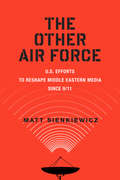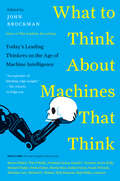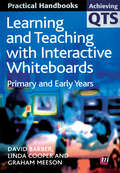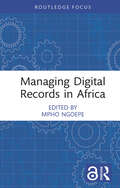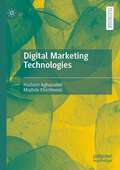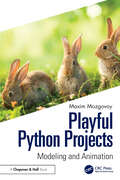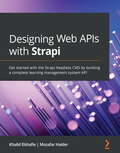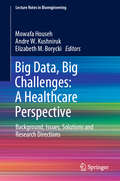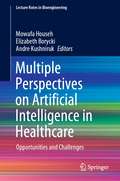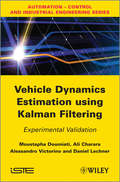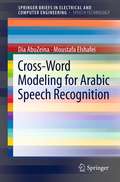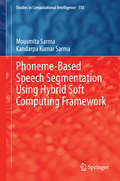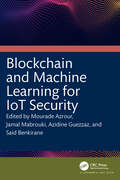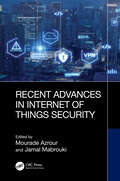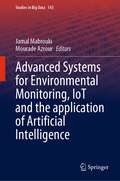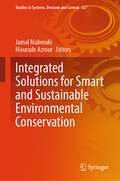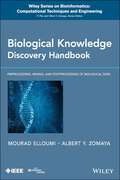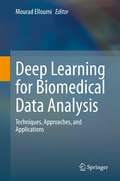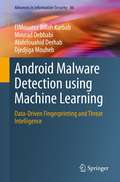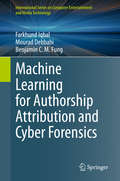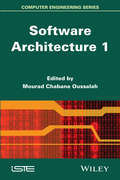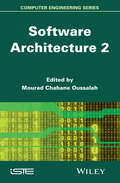- Table View
- List View
EMBOSS Developer's Guide:
by Mr Peter Rice Dr Alan Bleasby Dr Jon Ison Dr Jon Ison Mr Peter RiceThe European Molecular Biology Open Software Suite (EMBOSS) is a high quality, well documented package of open source software tools for molecular biology. EMBOSS includes extensive and extensible C programming libraries, providing a powerful and robust toolkit for developing new bioinformatics tools from scratch. The EMBOSS Developer's Manual is the official and definitive guide to developing software under EMBOSS. It includes comprehensive reference information and guidelines, including step-by-step instructions and real-world code examples: • Learn how to write fully-featured tools guided by the people who developed EMBOSS • Step-by-step guide to writing EMBOSS applications, illustrated with functional, deployed code • ACD file development – learn how to customise existing tools without coding, or design and write entirely new application interfaces • EMBOSS API programming guidelines – quickly master application development • Wrapping and porting applications under EMBOSS – learn how to incorporate third-party tools
The Other Air Force: U.S. Efforts to Reshape Middle Eastern Media Since 9/11
by Mr Matt SienkiewiczAs it seeks to win the hearts and minds of citizens in the Muslim world, the United States has poured millions of dollars into local television and radio programming, hoping to generate pro-American currents on Middle Eastern airwaves. However, as this fascinating new book shows, the Middle Eastern media producers who rely on these funds are hardly puppets on an American string, but instead contribute their own political and creative agendas while working within U.S. restrictions. The Other Air Force gives readers a unique inside look at television and radio production in Afghanistan and the Palestinian territories, from the isolated villages of the Afghan Panjshir Valley to the congested streets of Ramallah. Communications scholar Matt Sienkiewicz explores how the U.S. takes a "soft-psy" approach to its media efforts combining "soft" methods of encouraging entertainment programming, such as adaptations of The Voice and The Apprentice with more militaristic "psy-ops" approaches to information control. Drawing from years of field research and interviews with everyone from millionaire executives to underpaid but ever resourceful cameramen, Sienkiewicz considers the perspectives of the Afghan and Palestinian media workers trying to forge viable broadcasting businesses without straying outside American-set boundaries for acceptable content. As it carefully examines the interplay of U.S. military and economic might with the capacity for local ingenuity and resistance, the book also analyzes the intriguingly complex programming that emerges from this tension. Combining eyewitness reportage with cutting-edge scholarship, The Other Air Force reveals the remarkable creative output that can emerge even from the world's tensest conflict zones.
What to Think About Machines That Think: Today's Leading Thinkers on the Age of Machine Intelligence
by Mr John BrockmanAs the world becomes ever more dominated by technology, John Brockman’s latest addition to the acclaimed and bestselling “Edge Question Series” asks more than 175 leading scientists, philosophers, and artists: What do you think about machines that think? <P><P> The development of artificial intelligence has been a source of fascination and anxiety ever since Alan Turing formalized the concept in 1950. Today, Stephen Hawking believes that AI “could spell the end of the human race.” At the very least, its development raises complicated moral issues with powerful real-world implications—for us and for our machines. <P> In this volume, recording artist Brian Eno proposes that we’re already part of an AI: global civilization, or what TED curator Chris Anderson elsewhere calls the hive mind. And author Pamela McCorduck considers what drives us to pursue AI in the first place. <P> On the existential threat posed by superintelligent machines, Steven Pinker questions the likelihood of a robot uprising. Douglas Coupland traces discomfort with human-programmed AI to deeper fears about what constitutes “humanness.” Martin Rees predicts the end of organic thinking, while Daniel C. Dennett explains why he believes the Singularity might be an urban legend.
Learning and Teaching with Interactive Whiteboards: Primary and Early Years (Achieving QTS Practical Handbooks Series)
by David Barber Linda Cooper Mr Graham MeesonInteractive Whiteboards (IWBs) are becoming increasingly common in schools and early years settings, and it is important for trainees to be equipped with the necessary skills and understanding to use them effectively to enhance learning. This book takes a thematic approach, examining all the key issues required to get the most out of this versatile learning technology. All chapters contain case studies from a range of subject areas and across the key stages, ensuring the text is rooted in the reality of the primary classroom and its curriculum.
Managing Digital Records in Africa
by Mpho NgoepeManaging Digital Records in Africa draws on the research work of the InterPARES Trust (ITrust) project that investigated interrelated archival issues focusing on legal analysis, infrastructure, trust, authentication, and education within the African context. This research-focused book provides a legal analysis and systematic assessment of how African institutions manage digital records in four countries (i.e., Botswana, Kenya, South Africa, and Zimbabwe). It also examines the extent to which records are managed using Internet-based applications, trust in such records, and digital record authentication to support the auditing process. Finally, it provides a curriculum analysis in digital records at institutions of higher learning in 38 African countries. The book's case studies illustrate the threads of discussion, which span the ITrust domains of legislation, infrastructure, authentication, trust, and education in archives and records management. The book can be used as a premier reference source by private and public organizations, researchers, educators, archivists, records managers, and postgraduate students to make informed decisions about digital records, records management systems, cloud-based services, authenticating records, and identifying universities on the continent that offer archival programmes. The book may also find expression to practitioners in other fields such as law and auditing.
Digital Marketing Technologies
by Hashem Aghazadeh Mozhde KhoshnevisThis book argues that digital marketing should benefit from emerging technologies to result in sustainable competitive values for businesses in both the digital and physical worlds. It not only explores digital marketing fundamentals, analysis, strategy, practices, and implementation but also explains the applications and relationships of marketing technologies (martechs) with digital marketing; as well as offers several real cases of practicing marketing technologies. It carefully describes how modern businesses offer their value propositions both digitally and physically applying emerging technologies specifically marketing technologies (martechs) and how consumers are using these new technologies particularly artificial intelligence (ChatGPT/ OpenAI). It investigates why consumers are so intrigued and interested in digital relationships, interaction, and shopping experiences. It critically examines and argues that digital marketing has become popular among businesses as they areattempting to serve their customers better by taking advantage of using digital marketing technologies (marketchs).
Playful Python Projects: Modeling and Animation
by Mozgovoy MaximThis book aims to take beginner and intermediate programming hobbyists to the next level by challenging them with exciting bite-size projects rooted in actual scientific and engineering problems.Each chapter introduces a set of simple techniques and shows a variety of situations where they can be applied. The main feature of the book is the choice of topics that are designed to be both entertaining and serious. Most of the projects strive to analyze or simulate something found in the real world, covering molecules and planets, plants and animals, bacteria and robots. Engaging in these excursions is a great way to hone coding skills while exploring diverse areas of human knowledge.The variety of discussed subjects and creative project ideas make the book a perfect choice for aspiring coders thinking where to apply their growing skills.
Designing Web APIs with Strapi: Get started with the Strapi headless CMS by building a complete learning management system API
by Khalid Elshafie Mozafar HaiderLeverage the power of Strapi to build self-hosted, customizable, and performant content APIsKey FeaturesDiscover how Strapi can help you build APIs quickly and focus on your products and featuresLearn how to put Strapi into practice by implementing it in real-world scenariosUnderstand how to use Strapi's powerful features to customize your APIsBook DescriptionStrapi is a Node.js-based, flexible, open-source headless CMS with an integrated admin panel that anyone can use and helps save API development time. APIs built with Strapi can be consumed using REST or GraphQL from any client. With this book, you'll take a hands-on approach to exploring the capabilities of the Strapi platform and creating a custom API from scratch.This book will help JavaScript developers to put their knowledge to work by guiding them through building powerful backend APIs. You'll see how to effortlessly create content structures that can be customized according to your needs, and gain insights into how to write, edit, and manage your content seamlessly with Strapi. As you progress through the chapters, you'll discover a wide range of Strapi features, as well as understand how to add complex features to the API such as user authentication, data sorting, and pagination. You'll not only learn how to find and use existing plugins from the open-source community but also build your own plugins with custom functionality with the Strapi plugin API and add them to the admin panel. Finally, you'll learn how to deploy the API to Heroku and AWS.By the end of this book, you'll be able to build powerful, scalable, and secure APIs using Strapi.What you will learnExplore Strapi and understand how it worksDefine content types to build APIs quickly and efficientlyUnderstand authentication and authorization in StrapiCreate production-ready APIs with StrapiDeploy the Strapi API to various environments, including Heroku and AWSUse best practices to run the Strapi API in productionSync permissions to access the API between multiple environmentsWrite basic tests for API utilities as well as the endpointWho this book is forThis book is for backend and frontend JavaScript developers. Experienced API developers will learn a new, fast, and flexible way of building APIs, while frontend developers will be able to take a step toward becoming full-stack developers by learning how to leverage Strapi for building APIs quickly. Basic knowledge of JavaScript and REST API concepts is assumed.
Big Data, Big Challenges: Background, Issues, Solutions and Research Directions (Lecture Notes in Bioengineering)
by Mowafa Househ Andre W. Kushniruk Elizabeth M. BoryckiThis is the first book to offer a comprehensive yet concise overview of the challenges and opportunities presented by the use of big data in healthcare. The respective chapters address a range of aspects: from health management to patient safety; from the human factor perspective to ethical and economic considerations, and many more. By providing a historical background on the use of big data, and critically analyzing current approaches together with issues and challenges related to their applications, the book not only sheds light on the problems entailed by big data, but also paves the way for possible solutions and future research directions. Accordingly, it offers an insightful reference guide for health information technology professionals, healthcare managers, healthcare practitioners, and patients alike, aiding them in their decision-making processes; and for students and researchers whose work involves data science-related research issues in healthcare.
Multiple Perspectives on Artificial Intelligence in Healthcare: Opportunities and Challenges (Lecture Notes in Bioengineering)
by Mowafa Househ Elizabeth Borycki Andre KushnirukThis book offers a comprehensive yet concise overview of the challenges and opportunities presented by the use of artificial intelligence in healthcare. It does so by approaching the topic from multiple perspectives, e.g. the nursing, consumer, medical practitioner, healthcare manager, and data analyst perspective. It covers human factors research, discusses patient safety issues, and addresses ethical challenges, as well as important policy issues. By reporting on cutting-edge research and hands-on experience, the book offers an insightful reference guide for health information technology professionals, healthcare managers, healthcare practitioners, and patients alike, aiding them in their decision-making processes. It will also benefit students and researchers whose work involves artificial intelligence-related research issues in healthcare.
Vehicle Dynamics Estimation using Kalman Filtering: Experimental Validation (Wiley-iste Ser. #722)
by Ali Charara Daniel Lechner Alessandro Victorino Moustapha DoumiatiVehicle dynamics and stability have been of considerable interest for a number of years. The obvious dilemma is that people naturally desire to drive faster and faster yet expect their vehicles to be “infinitely” stable and safe during all normal and emergency maneuvers. For the most part, people pay little attention to the limited handling potential of their vehicles until some unusual behavior is observed that often results in accidents and even fatalities. This book presents several model-based estimation methods which involve information from current potential-integrable sensors. Improving vehicle control and stabilization is possible when vehicle dynamic variables are known. The fundamental problem is that some essential variables related to tire/road friction are difficult to measure because of technical and economical reasons. Therefore, these data must be estimated. It is against this background, that this book’s objective is to develop estimators in order to estimate the vehicle’s load transfer, the sideslip angle, and the vertical and lateral tire/road forces using a roll model. The proposed estimation processes are based on the state observer (Kalman filtering) theory and the dynamic response of a vehicle instrumented with standard sensors. These estimators are able to work in real time in normal and critical driving situations. Performances are tested using an experimental car in real driving situations. This is exactly the focus of this book, providing students, technicians and engineers from the automobile field with a theoretical basis and some practical algorithms useful for estimating vehicle dynamics in real-time during vehicle motion.
Cross-Word Modeling for Arabic Speech Recognition (SpringerBriefs in Speech Technology)
by Dia Abuzeina Moustafa ElshafeiCross-Word Modeling for Arabic Speech Recognition utilizes phonological rules in order to model the cross-word problem, a merging of adjacent words in speech caused by continuous speech, to enhance the performance of continuous speech recognition systems. The author aims to provide an understanding of the cross-word problem and how it can be avoided, specifically focusing on Arabic phonology using an HHM-based classifier.
Phoneme-Based Speech Segmentation using Hybrid Soft Computing Framework
by Mousmita Sarma Kandarpa Kumar SarmaThe book discusses intelligent system design using soft computing and similar systems and their interdisciplinary applications. It also focuses on the recent trends to use soft computing as a versatile tool for designing a host of decision support systems.
Emerging IT/ICT and AI Technologies Affecting Society (Lecture Notes in Networks and Systems #478)
by Mousmi Ajay Chaurasia Chia-Feng JuangThis book presents the applications of future technologies to overcome the toughest humanitarian challenges from an engineering approach. COVID-19, a worldwide pandemic, has limited many physical operational areas and at the same time has motivated to uplift the initiative to digitalize the world. Society is facing ever more intense and protracted humanitarian crises, and as a result, the global community is pressed to find new ways to help people and communities in need. This interdisciplinary book highlights the exchange of relevant trends and research results as well as the presentation of practical experiences gained while developing and testing elements of technology enhanced learning experiences with the help of emerging technologies like IT/ICT, AI, ML, edge computing, robotics automation, 5G for the betterment of humanity. It highlights the analytics and optimization issues impacting society and technology for example on security, sustainability, identity, inclusion, working life, corporate and community welfare, and well-being of people to create a secure tomorrow.
Blockchain and Machine Learning for IoT Security
by Mourade Azrour, Jamal Mabrouki, Azidine Guezzaz, and Said BenkiraneThe Internet of Things (IoT) involves physical devices, cars, household appliances, and any other physical appliance equipped with sensors, software, and network connections to gather and communicate data. Nowadays, this technology is embedded in everything from simple smart devices, to wearable equipment, to complex industrial machinery and transportation infrastructures. On the other hand, IoT equipment has been designed without considering security issues. Consequently, there are many challenges in terms of protection against IoT threats, which can lead to distressing situations. In fact, unlike other technological solutions, there are few standards and guidelines governing the protection of IoT technology. Moreover, few users are aware of the risks associated with IoT systems. Hence, Blockchain and Machine Learning for IoT Security discusses various recent techniques and solutions related to IoT deployment, especially security and privacy. This book addresses a variety of subjects, including a comprehensive overview of the IoT, and covers in detail the security challenges at each layer by considering how both the architecture and underlying technologies are employed. As acknowledged experts in the field, the authors provide remediation solutions for impaired security, as well as mitigation methods, and offer both prevention and improvement suggestions. Key Features: Offers a unique perspective on IoT security by introducing Machine Learning and Blockchain solutions Presents a well-rounded overview of the most recent advances in IoT security and privacy Discusses practical solutions and real-world cases for IoT solutions in various areas Provides solutions for securing IoT against various threats Discuses Blockchain technology as a solution for IoT This book is designed to provide all the necessary knowledge for young researchers, academics, and industry professionals who want to understand the advantages of artificial intelligence technology, machine learning, data analysis methodology, and Blockchain for securing IoT technologies.
Recent Advances in Internet of Things Security
by Mourade Azrour and Jamal MabroukiThe growth of the Internet of Things (IoT) technology has indeed led to an increase in cybersecurity issues. While the Internet of Things enhances accessibility, integrity, availability, scalability, confidentiality, and interoperability among devices, it also faces vulnerabilities due to its diverse attack sources and lack of standardization in security protocols. This makes Internet of Things systems particularly susceptible to cyberattacks. It is essential to ensure proper security measures are in place to protect Internet of Things devices and networks, given their critical role in modern communications and the evolving threat landscape. Always remember to verify important security information from trusted sources.Recent Advances in Internet of Things Security discusses the critical importance of robust security frameworks to protect Internet of Things ecosystems against various cyber threats. It highlights the security risks associated with Internet of Things devices and applications and presents a variety of potential solutions. It is essential to remain aware of these challenges to effectively safeguard Internet of Things systems. This book delves into the complexities of IoT security, exploring a range of vulnerabilities across different layers of the IoT architecture.The book provides a comprehensive overview of Internet of Things security, emphasizing the significance of securing Internet of Things products and applications. It serves as a foundational resource for young researchers, academics, and industry professionals keen on advanced security solutions within the Internet of Things landscape, reflecting the current state of research and ongoing challenges in this field.
Advanced Systems for Environmental Monitoring, IoT and the application of Artificial Intelligence (Studies in Big Data #143)
by Mourade Azrour Jamal MabroukiEnvironmental risks put one in six people at risk, as well as our complex ecosystems. Today, IoT sites can monitor the environment and assess risks. Clean technologies can help detect toxic substances, chemical spills, hazardous pollutants, and other issues, enabling both governments and industries to clean or protect the air, land, water, and other environments, and how IoT can support these processes. IoT-enabled environmental intelligence is the constant measurement and collection of our physical environment, through sensors and smart devices. Integrated sensors in irrigation facilities, water supply systems, pipelines, cisterns, weather stations, ocean, and industrial facilities—anywhere on the globe—can record temperature, relative humidity, water content, leaks, and any other physical parameters.
Integrated Solutions for Smart and Sustainable Environmental Conservation (Studies in Systems, Decision and Control #527)
by Mourade Azrour Jamal MabroukiResource depletion and ecological risks are more than ever at the heart of societal and economic debates. In the 1970s, the developed countries saw the Fordist growth regime crumble in parallel with the growing awareness of the ecological issue. Since the first industrial revolutions, technological dynamics have been the cause of many environmental problems, and there is a consensus on the diagnosis. Integrated technologies reduce resource use and/or pollution at source by using cleaner production methods. This generally leads to a reduction in the by-products, energy inputs and resources used by companies to produce goods. Integrated production technologies reduce negative environmental impacts at source by substituting or modifying cleaner technologies. Examples of integrated, or cleaner, production technologies are the recirculation of materials, the use of environmentally friendly materials (such as the substitution of water for organic solvents), etc. However, the implementation of integrated production technologies is often hampered by obstacles related to cost, coordination and skill inertia problems and to the productive organisation of companies. In addition to the high investment costs of new integrated technologies, additional barriers may emerge depending on the nature of the environmental problem and the type of environmental regulation in question.
Smart Internet of Things for Environment and Healthcare (Studies in Computational Intelligence #1165)
by Mourade Azrour Jamal Mabrouki Azidine Guezzaz Abdulatif Alabdulatif Fatima AmounasNowadays, the efficient sustainable systems are becoming more and more important for sustainable life either in urban and in rural environments. Despite the advances in technologies, it is always important to consider the environment where we live. Hence, the present book presents some recent and fresh works that deal with environmental problems including water quality, wastewater management, air pollution monitoring, renewable energy solutions, food security solutions, and so on. Besides, the book investigates different applications of Artificial Intelligence for previous environmental issues. This book is targeting junior researchers, graduate and graduate students, environmental specialists, and all people who want to learn more about recent advancement in environmental solutions.
Biological Knowledge Discovery Handbook: Preprocessing, Mining and Postprocessing of Biological Data (Wiley Series in Bioinformatics #23)
by Mourad Elloumi Albert Y. ZomayaThe first comprehensive overview of preprocessing, mining, and postprocessing of biological data Molecular biology is undergoing exponential growth in both the volume and complexity of biological data—and knowledge discovery offers the capacity to automate complex search and data analysis tasks. This book presents a vast overview of the most recent developments on techniques and approaches in the field of biological knowledge discovery and data mining (KDD)—providing in-depth fundamental and technical field information on the most important topics encountered. Written by top experts, Biological Knowledge Discovery Handbook: Preprocessing, Mining, and Postprocessing of Biological Data covers the three main phases of knowledge discovery (data preprocessing, data processing—also known as data mining—and data postprocessing) and analyzes both verification systems and discovery systems. BIOLOGICAL DATA PREPROCESSING Part A: Biological Data Management Part B: Biological Data Modeling Part C: Biological Feature Extraction Part D Biological Feature Selection BIOLOGICAL DATA MINING Part E: Regression Analysis of Biological Data Part F Biological Data Clustering Part G: Biological Data Classification Part H: Association Rules Learning from Biological Data Part I: Text Mining and Application to Biological Data Part J: High-Performance Computing for Biological Data Mining Combining sound theory with practical applications in molecular biology, Biological Knowledge Discovery Handbook is ideal for courses in bioinformatics and biological KDD as well as for practitioners and professional researchers in computer science, life science, and mathematics.
Deep Learning for Biomedical Data Analysis: Techniques, Approaches, and Applications
by Mourad ElloumiThis book is the first overview on Deep Learning (DL) for biomedical data analysis. It surveys the most recent techniques and approaches in this field, with both a broad coverage and enough depth to be of practical use to working professionals. This book offers enough fundamental and technical information on these techniques, approaches and the related problems without overcrowding the reader's head. It presents the results of the latest investigations in the field of DL for biomedical data analysis. The techniques and approaches presented in this book deal with the most important and/or the newest topics encountered in this field. They combine fundamental theory of Artificial Intelligence (AI), Machine Learning (ML) and DL with practical applications in Biology and Medicine. Certainly, the list of topics covered in this book is not exhaustive but these topics will shed light on the implications of the presented techniques and approaches on other topics in biomedical data analysis. The book finds a balance between theoretical and practical coverage of a wide range of issues in the field of biomedical data analysis, thanks to DL. The few published books on DL for biomedical data analysis either focus on specific topics or lack technical depth. The chapters presented in this book were selected for quality and relevance. The book also presents experiments that provide qualitative and quantitative overviews in the field of biomedical data analysis. The reader will require some familiarity with AI, ML and DL and will learn about techniques and approaches that deal with the most important and/or the newest topics encountered in the field of DL for biomedical data analysis. He/she will discover both the fundamentals behind DL techniques and approaches, and their applications on biomedical data. This book can also serve as a reference book for graduate courses in Bioinformatics, AI, ML and DL. The book aims not only at professional researchers and practitioners but also graduate students, senior undergraduate students and young researchers. This book will certainly show the way to new techniques and approaches to make new discoveries.
Android Malware Detection using Machine Learning: Data-Driven Fingerprinting and Threat Intelligence (Advances in Information Security #86)
by Mourad Debbabi Djedjiga Mouheb ElMouatez Billah Karbab Abdelouahid DerhabThe authors develop a malware fingerprinting framework to cover accurate android malware detection and family attribution in this book. The authors emphasize the following: (1) the scalability over a large malware corpus; (2) the resiliency to common obfuscation techniques; (3) the portability over different platforms and architectures.First, the authors propose an approximate fingerprinting technique for android packaging that captures the underlying static structure of the android applications in the context of bulk and offline detection at the app-market level. This book proposes a malware clustering framework to perform malware clustering by building and partitioning the similarity network of malicious applications on top of this fingerprinting technique. Second, the authors propose an approximate fingerprinting technique that leverages dynamic analysis and natural language processing techniques to generate Android malware behavior reports. Based on this fingerprinting technique, the authors propose a portable malware detection framework employing machine learning classification. Third, the authors design an automatic framework to produce intelligence about the underlying malicious cyber-infrastructures of Android malware. The authors then leverage graph analysis techniques to generate relevant intelligence to identify the threat effects of malicious Internet activity associated with android malware.The authors elaborate on an effective android malware detection system, in the online detection context at the mobile device level. It is suitable for deployment on mobile devices, using machine learning classification on method call sequences. Also, it is resilient to common code obfuscation techniques and adaptive to operating systems and malware change overtime, using natural language processing and deep learning techniques.Researchers working in mobile and network security, machine learning and pattern recognition will find this book useful as a reference. Advanced-level students studying computer science within these topic areas will purchase this book as well.
Machine Learning for Authorship Attribution and Cyber Forensics (International Series on Computer Entertainment and Media Technology)
by Mourad Debbabi Benjamin C. Fung Farkhund IqbalThe book first explores the cybersecurity’s landscape and the inherent susceptibility of online communication system such as e-mail, chat conversation and social media in cybercrimes. Common sources and resources of digital crimes, their causes and effects together with the emerging threats for society are illustrated in this book. This book not only explores the growing needs of cybersecurity and digital forensics but also investigates relevant technologies and methods to meet the said needs. Knowledge discovery, machine learning and data analytics are explored for collecting cyber-intelligence and forensics evidence on cybercrimes.Online communication documents, which are the main source of cybercrimes are investigated from two perspectives: the crime and the criminal. AI and machine learning methods are applied to detect illegal and criminal activities such as bot distribution, drug trafficking and child pornography. Authorship analysis is applied to identify the potential suspects and their social linguistics characteristics. Deep learning together with frequent pattern mining and link mining techniques are applied to trace the potential collaborators of the identified criminals.Finally, the aim of the book is not only to investigate the crimes and identify the potential suspects but, as well, to collect solid and precise forensics evidence to prosecute the suspects in the court of law.
Software Architecture 1
by Mourad Chabane OussalahOver the past 20 years, software architectures have significantly contributed to the development of complex and distributed systems. Nowadays, it is recognized that one of the critical problems in the design and development of any complex software system is its architecture, i.e. the organization of its architectural elements. Software Architecture presents the software architecture paradigms based on objects, components, services and models, as well as the various architectural techniques and methods, the analysis of architectural qualities, models of representation of architectural templates and styles, their formalization, validation and testing and finally the engineering approach in which these consistent and autonomous elements can be tackled.
Software Architecture 2
by Mourad Chabane OussalahOver the past 20 years, software architectures have significantly contributed to the development of complex and distributed systems. Nowadays, it is recognized that one of the critical problems in the design and development of any complex software system is its architecture, i.e. the organization of its architectural elements. Software Architecture presents the software architecture paradigms based on objects, components, services and models, as well as the various architectural techniques and methods, the analysis of architectural qualities, models of representation of architectural templates and styles, their formalization, validation and testing and finally the engineering approach in which these consistent and autonomous elements can be tackled.

